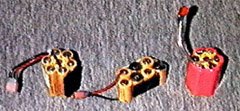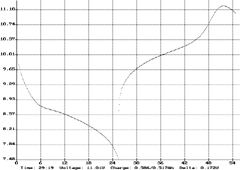Using Sanyo 1100AAU Cells for Speed 400
April 2, 1999
At KRC’98, I purchased an 8-cell Sanyo 1100AAU pack to use in my JR XP642 transmitter. Since I use this transmitter for most of my planes, it gets a lot of use during a day of flying, so I wanted more capacity than the 600mAh provided by the factory pack.
A few months ago, I saw that East Coast Model Center was advertising individual 1100AAU cells for Cdn $5.99 (about US $4.00) each. I decided I’d give these a try as a power source for my Sydney’s Special, a Speed 400 sport plane I’ve been flying with 7x600AA packs for about a year now. Flights with this 37in span, 270 sq.in, 17.5oz (94cm, 17.4dm2, 500g) plane have been around the 6 to 7 minute mark, mostly at half throttle. Flying at full throttle, Sydney can just finish a 4-minute EMFSO Speed 400 sport pylon race.
I ordered a set of seven 1100AAU cells, and assembled them into a hexagonal pack (one cell in the middle, six around it), using the same assembly techniques, wire, and connectors as on my 600AA packs. The photo shows, from left to right, 7x600AA, 7x600AE, and 7x1100AAU (I ran out of clear heat-shrink).
I cycled the pack on my computer controlled battery analyzer until the capacity stopped increasing. After four cycles, the capacity levelled of at 1.099Ah when discharged at 1.2A
The first test flight was phenomenal! Sydney climbed out with her usual authority, and after a few seconds of climbing, I throttled back to half throttle and started flying figure eights. Occasionally I’d get too high and do a few loops (from a slight dive, still at half throttle). My ESC has a gradual motor cut-off instead of a sudden one, so I bumped the throttle from time to time to see if it could still provide full power. When it no longer could, I landed and looked at the clock: 14 minutes of cruising flight with mild aerobatics. After returning home, I discharged the pack to determine how much capacity I’d used. There was 88mAh left, indicating I’d used just over 1Ah.
The Numbers
Being a technically minded person, I also did some tests using my battery analyzer to compare the performance of 600AA, 600AE, and 1100AAU packs. For the 600AA and 600AE packs, I used the results from my best packs. For the 1100AAU, I used the results from my one and only pack. Each pack was cycled at 1.2A until its capacity no longer increased. Here’s the executive summary:
| Pack Description | Weight | Capacity (Ah) | Energy (Wh) | Average Voltage |
|---|---|---|---|---|
| 7 x 600AA | 5.7oz (161g) | 0.517 | 4.42 | 8.55 |
| 7 x 600AE | 4.7oz (133g) | 0.561 | 4.78 | 8.52 |
| 7 x 1100AAU | 6.1oz (173g) | 1.099 | 9.51 | 8.65 |
Notice that the 600AA pack delivers significantly less that 0.6Ah, and the 600AE pack a bit less than 0.6Ah. The 1100AAU pack lives up to its name, giving almost 1.1Ah. Furthermore, the average voltage delivered by the 1100AAU pack is higher, indicating a lower internal resistance, and further increasing the total energy output of the pack. The 1100AAU pack can deliver over twice the total amount of energy as the 600AA pack, and almost twice the total energy of the 600AE pack.
The 1100AAU pack is only 0.4oz (12g) heavier than the the same-sized 600AA pack, and thus can be used as a direct replacement, as I did in my Sydney’s Special.
The Pictures
The following three graphs (click on them to enlarge them) are from the last cycle done on each pack. First is the 600AA pack. Notice that even after the initial drop, the discharge curve is quite steep, dropping from about 8.8V at the 6 minute mark, to about 8.3V at 18 minutes.
Next is the 600AE pack. The discharge curve is about as steep as the one for the 600AA pack (it doesn’t look that way because the scales of the graphs are different). The overall capacity is a bit higher.
Finally, here’s the graph for the 1100AAU pack. Notice that the discharge curve is very flat, much more like an AR type cell. The voltage drops from about 8.8V at 13 minutes to about 8.5V at 39 minutes, and then starts to drop more rapidly after that. This alone makes the 1100AAU more suitable to electric flight than either the 600AA or 600AE. And of course, the capacity is nearly doubled.
Conclusions
That the Sanyo 1100AAU cells haven’t been talked about more is a mystery to me. This cells is ideal for Speed 400 flying, providing about twice the capacity of 600mAh cells at a very modest increase in weight (only 7% heavier than 600AA, or 29% heavier than 600AE). The discharge curve is nice and flat, giving consistent power levels throughout a flight. Only time will tell how well these cells hold up under use, but so far, they look promising.
Related Articles
If you've found this article useful, you may also be interested in:
- What About the Wires?
- The Battery Eliminator Circuit
- On Fuses in Electric Flight
- Electric Flight Wiring
- NiCd and NiMH Battery Care
- To BEC or Not To BEC
- Electric Flight Power Connectors
- An Electronic Speed Control Primer

If you've found this article useful, consider leaving a donation in Stefan's memory to help support stefanv.com
Disclaimer: Although every effort has been made to ensure accuracy and reliability, the information on this web page is presented without warranty of any kind, and Stefan Vorkoetter assumes no liability for direct or consequential damages caused by its use. It is up to you, the reader, to determine the suitability of, and assume responsibility for, the use of this information. Links to Amazon.com merchandise are provided in association with Amazon.com. Links to eBay searches are provided in association with the eBay partner network.
Copyright: All materials on this web site, including the text, images, and mark-up, are Copyright © 2025 by Stefan Vorkoetter unless otherwise noted. All rights reserved. Unauthorized duplication prohibited. You may link to this site or pages within it, but you may not link directly to images on this site, and you may not copy any material from this site to another web site or other publication without express written permission. You may make copies for your own personal use.



